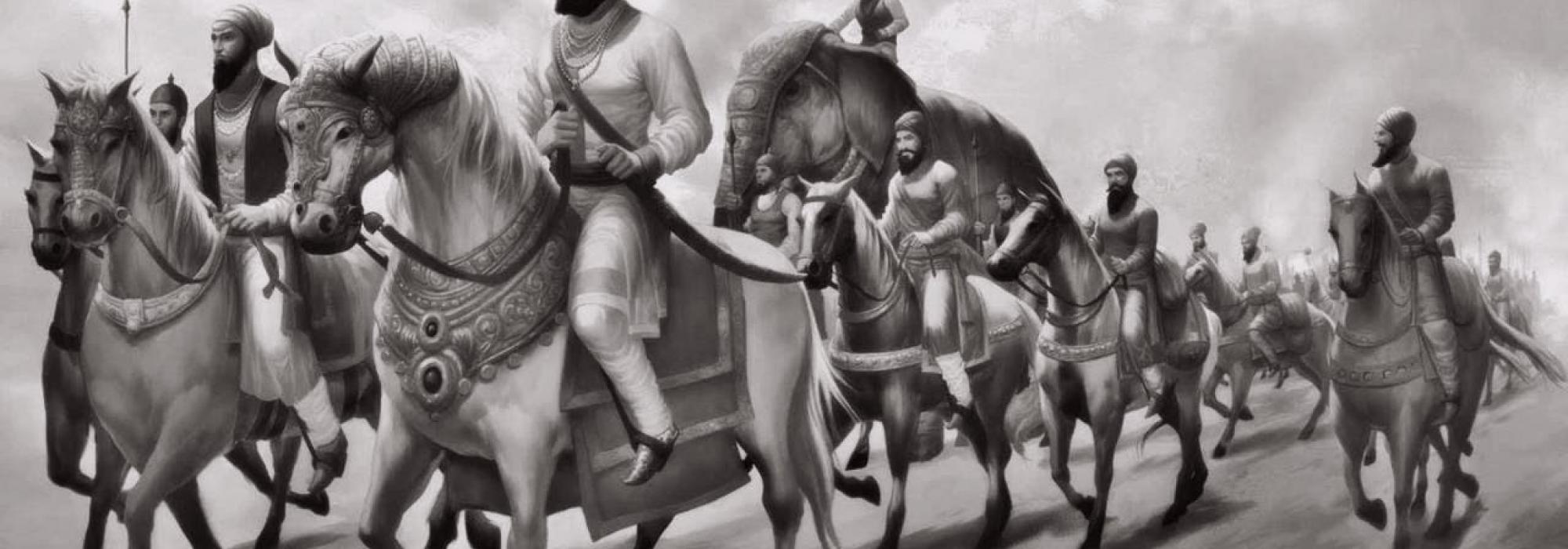Deeply pained at the persecution and suffering of his children and followers, Gobind Singh decided to form a separate sect in order to fight the Mughals. This was how the Khalsa Panth was born: to protect the Hindu people who were following their tradition peacefully. In Gobind Singh’s own words:
Chidiyon se mein baaz banaaoon |
Savva laakh se ek ladhaaoon ||
I will make hawks out of sparrows |
I will fight lakhs of soldiers alone ||
In the Vaishakha Month of 1699 on the solemn occasion of the Baisakhi festival, about eighty thousand people had assembled in a town called Nayanadevi. On that occasion, Gobind Singh thundered, flashing a sword:
During the present time, we must offer our Puja to Chandi Devi in order to protect the country. But that Puja must not involve incense and lamp but blood. Who among you are ready to offer your blood?
A Brahmana named Dayaram Khatri came forward. Gobind Singh pulled him inside a room. A slashing sound emanated from within. Then, Gobind Singh emerged with a bloody sword in his hand. Next, a Jat youth from Delhi named Dharmadas came forward. Then it was the turn of a washerman named Mohak Chand from Dwaraka. After him was a barber from Bidar (in today’s Karnataka) named Saheb Chand; then came a water-seller named Himmat Raya from Jagannath Puri. The same scene was repeated: Gobind Singh would emerge with the same bloody sword.
Gobind Singh’s mother, Gujari Devi exclaimed, “Enough! Stop these killings!” At this, Gobind Singh brought out all the five volunteers. He had actually killed five goats. He said to crowd, “Mera paanch pyaare!” (The Five who are dear to me!). This was how Gobind Singh had selected five people who were ready to sacrifice their lives. Of these, three members belonged to what is known as the lower castes, and two from the upper castes. Said Gobind Singh:
Hey Araj tu khaalis hove |
Hams Hams sheesh dharma hita kove ||
You Five have become sanctified, you have become Aryas; you are ready to sacrifice your lives for the sake of Dharma. Because of this, Mother has become very pleased. Going forward, build a large army. Let this become a new Path.
After this, Gobind Singh prepared a mixture of milk and water and got their respective mothers to add sugar to it. He stirred the mixture with his sword and with his own hands, made them drink it. Then he takes the Diksha from his own disciples. When the gathering witnessed this scene, they spontaneously exclaimed, “Wahe Guru!” This eventually became a sacred Mantra.
Thousands of people took Diksha into this new sect. This is the Diksha involving the Five Kha alphabets: Kesh (hair), Khang (comb), KhaDa (an iron bangle always to be worn on the wrist), Khacchh (wearing the Dhoti wrapped around the legs like a trouser) and KripaN (sword). Gobind Singh says further:
Sakala jagat mein Khalsa panth gaaje |
Jage Sakala Dharma Hindu bandha baaje ||
Let the Khalsa Panth roar like a lion throughout the world|
Let Hindu Dharma rejuvenate ||
In this manner, Guru Gobind Singh built up a vast force of warriors out of the Khalsa Panth. He preached equality of women and men, opposed the practice of Sati, encouraged widow remarriage and advocated compassion and love towards the poor and the downtrodden.
If these followers were all Keshadharis (those who never cut their hair), another non-warrior sect named Sahajadharis, eventually grew. Guru Gobind Singh dispatched five of his disciples named Karma Singh, Khada Singh, Veer Singh, Sena Singh, and Ram Singh to Kashi to study Vedas and Upanishads. In time, this led to the formation of the Nirmal Panth.
Whereas the Khalsa Panth advocated Kshatra, the Nirmal Panth advocated Brahma. In this manner, the Vedic conch of Yatra Brahma ca Kshatram ca… sounded once more.
As a fortuitous coincidence of sorts, Punjab lies in the Veda Bhoomi itself. Or in the general region of today’s Haryana’s “Brahmavarta,” which was originally intertwined with Punjab.
Saraswati Drishadwatyordevanadyoryadantaram |
tam Deva nirmitam desham Brahmaavartam pracakshate ||
(Manusmriti II-17)
According to this verse, today’s Kurukshetra is Brahmavarta. This land is where the Vedas originated. Illustrious scholars like Sri Sediyappu Krishnabhatta have written about this in detail in his Tathya Darshana. The Khalsa Panth thus originated in this sanctified region.
The Sikh sect fused the Brahma and Kshatra ideals once again. A measure of the blazing Kshatra tradition among the Sikhs can be seen in the fact that there is not a single beggar in this community. But in the present time, we are actually insulting this noble Sikh tradition by cracking mindless Sardarji jokes.
The Sikhs form a paltry two percent of India’s population. But they constitute ninety percent of all the people who sacrificed their lives and limbs during the freedom struggle! The total number of Indians who were hanged by the British were 120. Of these, 93 were Sikhs! The total number of Indians dispatched to the dreaded Kala Pani (Andaman Islands) is 2646. Of these, 2147 were Sikhs! The total number of Indians killed in the Jallianwala Bagh genocide was about 1300. Of these, 799 were Sikhs! The total lives extinguished by the British during the freedom struggle is approximately 4279; of these, 3197 were Sikhs!
These numbers in themselves show the glorious valour and patriotism of the Sikhs. However, post-Independence, thanks to the selfishness, greed, and lust for power on the part of our political leaders, and the lack of foresight of some Sikh political leaders, the Sikhs have more or less completely splintered away from their mothership of Sanatana Dharma.
None of this would be acceptable by Guru Gobind Singh and the entire Sikh Guru Parampara. What’s more, the tendencies of Sikh separatism which has shown signs of revival in recent times is actually against the original ideals and goals of the Sikh Gurus.
How does one rectify this?
To be continued

















































